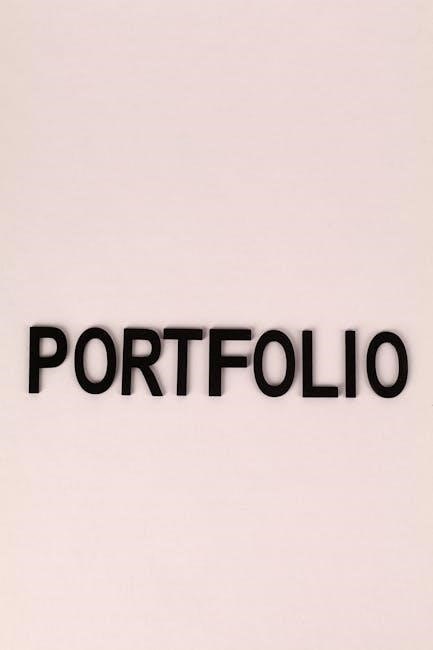A graphic design portfolio PDF is a digital showcase of a designer’s creative vision, technical skills, and professional journey, highlighting their best work and design capabilities.
What is a Graphic Design Portfolio PDF?
A graphic design portfolio PDF is a curated digital document showcasing a designer’s creative and technical abilities through selected projects. It typically includes a cover page, project highlights, contact information, and case studies. This format allows designers to present their work professionally, whether for job applications or client engagements. A well-structured portfolio PDF demonstrates a designer’s problem-solving skills and aesthetic sense, making it essential for career advancement. It should be visually appealing, easy to navigate, and optimized for digital platforms. Including high-quality images, clear typography, and interactive elements enhances engagement. A strong portfolio PDF is a testament to a designer’s expertise and creativity, helping them stand out in a competitive industry.
Why is a Portfolio Essential for Graphic Designers?
A portfolio is vital for graphic designers as it serves as a visual resume, showcasing their skills and creativity to potential employers or clients. It allows designers to demonstrate their expertise in various design areas, such as branding, typography, and digital media. A well-crafted portfolio highlights a designer’s ability to solve problems and deliver impactful solutions. It also helps differentiate them in a competitive market, making it easier to attract new opportunities. Additionally, a portfolio provides a platform to tell the story behind their work, connecting their creative vision with real-world applications. This makes it an indispensable tool for advancing their careers and building a professional reputation.

Structure of a Graphic Design Portfolio PDF
The structure of a graphic design portfolio PDF is a strategic organization of content, showcasing selected works, case studies, and contact information in a logical, visually consistent format.
Cover Page: First Impressions Matter
The cover page is the first thing potential employers or clients see, making it crucial for creating a strong impression. It should be clean, professional, and reflective of your personal brand. Use high-quality visuals or typography that align with your design style. Include your name, contact information, and a brief tagline or statement that captures your creative essence. Avoid clutter and ensure the design is minimalist yet impactful. This page sets the tone for the rest of your portfolio, so it’s essential to make it memorable and polished. A well-designed cover page can immediately convey your professionalism and artistic vision, encouraging viewers to explore further.
Project Showcase: Highlighting Your Best Work
The project showcase is the heart of your portfolio, displaying your most compelling and relevant work. Select projects that demonstrate your technical skills, creativity, and problem-solving abilities. Use high-quality images and layouts that make your work stand out. Provide context for each project, explaining the objective, your role, and the results. This helps viewers understand your process and impact. Keep the focus on variety, showing versatility across different design types, such as logos, branding, brochures, or digital designs. Ensure each project tells a story, showcasing your unique perspective and expertise. This section should leave a lasting impression, proving your value as a graphic designer.
Contact Information: Making It Easy to Connect
Your contact information is essential for potential clients or employers to reach you. Include your name, email address, phone number, and professional website or portfolio link. Add social media handles like LinkedIn or Instagram, where your work is showcased. Ensure the information is clear, legible, and easy to find. Place it on a dedicated page or integrate it into the cover page for visibility. Use clickable links in the PDF to make it interactive. Keep the design clean and professional, avoiding overly decorative fonts that may distract from the details. This section should be straightforward, ensuring anyone interested in your work can connect with you effortlessly. Make sure to update your contact information regularly to maintain professionalism and accessibility.

Key Elements to Include in Your Graphic Design Portfolio PDF
Highlight your creative journey, showcasing diverse projects, skills, and case studies. Include contact information and ensure visuals are high-quality and the layout is clean and professional.

About Section: Sharing Your Story
Your “About” section is where you introduce yourself, sharing your creative journey, passions, and goals. This is your chance to connect personally with employers or clients, showcasing your unique perspective and what drives your design process. Keep it concise yet engaging, highlighting your background, skills, and aspirations. Use this space to explain how you approach design challenges and what inspires your work. A well-crafted “About” section helps build trust and establishes your identity as a graphic designer. Make sure it reflects your personality while remaining professional. This personal touch can set you apart and leave a lasting impression on those reviewing your portfolio.
Skills and Services: Demonstrating Your Expertise
Your portfolio should clearly outline your skills and the services you offer as a graphic designer. This section helps employers or clients understand your capabilities and how you can meet their needs. List your technical skills, such as proficiency in Adobe Creative Suite, and any specialized areas like branding, typography, or digital design. Additionally, describe the services you provide, such as logo design, brochure creation, UI/UX design, or social media graphics. Be specific and tailored to your target audience, ensuring this section aligns with the type of work you want to attract. This clarity will help potential clients or employers see your value and expertise at a glance.
Case Studies: Detailed Breakdowns of Your Work
Case studies are a powerful way to showcase your problem-solving skills and design process. Each case study should provide a detailed breakdown of a specific project, including the challenge, your objectives, and the solutions you implemented. Highlight your creative approach, the tools you used, and the final outcome. This section demonstrates your ability to think critically and deliver effective results. By sharing the story behind your work, you reveal your expertise and versatility as a designer. Use visuals like concept sketches, drafts, and final designs to make your case studies engaging. This will help potential clients or employers understand your process and see the value you bring to a project. Keep it concise but informative to maintain their interest.

Design Tips for a Standout Portfolio PDF
Use a clean layout, high-quality visuals, and consistent typography to create a professional and visually appealing portfolio PDF that reflects your brand and design expertise.
Choosing the Right Layout and Typography
Choosing the right layout and typography is crucial for a professional graphic design portfolio PDF. Opt for a clean, minimalistic design that balances creativity with readability. Use grids and white space effectively to avoid clutter and ensure your work stands out. Select fonts that align with your brand and the tone of your designs, ensuring consistency across all pages. Avoid overly decorative fonts that may distract from your artwork. Ensure typography is legible on both desktop and mobile devices. Experiment with font sizes and spacing to create visual hierarchy, guiding the viewer’s eye through your portfolio. A well-designed layout and typography will enhance the overall impact of your work, making it easier for potential clients or employers to appreciate your skills.
Using High-Quality Images and Visuals
High-quality images and visuals are essential for a compelling graphic design portfolio PDF. Use high-resolution images that showcase your work with clarity and precision, ensuring they are optimally sized for digital viewing. Avoid pixelated or low-quality visuals, as they can undermine the professionalism of your portfolio. Compress files appropriately to maintain quality while keeping the PDF file size manageable. Ensure images are relevant and contextually placed to support your design narrative. Consider including before-and-after visuals or detailed close-ups to highlight your creative process and attention to detail. High-quality visuals not only enhance the aesthetic appeal of your portfolio but also demonstrate your commitment to excellence in your craft.
Keeping It Concise: Quality Over Quantity
Keep your graphic design portfolio PDF concise and focused, prioritizing quality over quantity. Aim for a streamlined presentation that highlights your strongest, most relevant work rather than overwhelming the viewer with excessive content. Curate your projects meticulously, ensuring each piece demonstrates a unique skill or creative approach. Avoid repetitive or outdated work that doesn’t align with your current design aesthetic or professional goals. A concise portfolio not only respects the viewer’s time but also reinforces your expertise and clarity of vision. Strike a balance between showcasing your range and maintaining a cohesive, easy-to-navigate format that leaves a lasting impression. This approach ensures your portfolio is both professional and engaging.

Optimizing Your Portfolio PDF for Digital Platforms
Ensure your graphic design portfolio PDF is optimized for digital viewing, with clear layouts, proper formatting, and compatibility across devices for a professional and seamless experience.
File Format and Size Considerations
When creating a graphic design portfolio PDF, choosing the right file format and optimizing size is crucial. Use PDF/A to ensure compatibility and preserve design integrity. Compress images to reduce file size without compromising quality, aiming for a balance between visuals and load times; Ensure the PDF is accessible on various devices by keeping the file size manageable, typically under 10MB. This makes it easier to share via email or online platforms. Additionally, consider password protection to safeguard your work, while still allowing viewers to navigate and view your portfolio seamlessly. Proper formatting ensures your portfolio is both professional and practical for digital sharing.
Ensuring Mobile Responsiveness
With the increasing use of mobile devices, ensuring your graphic design portfolio PDF is responsive is essential. This means your layout should adapt seamlessly to smaller screens without compromising readability or visual appeal. Use scalable designs and ensure text and images are legible on mobile devices. Avoid horizontal scrolling and ensure navigation is intuitive on touchscreens. Test your PDF on various devices to confirm compatibility and performance. A responsive design not only enhances user experience but also demonstrates your understanding of modern design principles. By optimizing for mobile, you make your portfolio accessible to a broader audience, ensuring your work is viewed professionally on any device.
Adding Interactive Elements for Engagement
Interactive elements can elevate your graphic design portfolio PDF by making it more engaging and dynamic. Consider incorporating clickable links to websites, social media, or live project demos. Embedding videos or animations can showcase your motion graphics skills and provide context to your work. Hyperlinks to case studies or detailed project explanations add depth without cluttering the layout. Interactive navigation, such as a table of contents with bookmarks, enhances usability. These features not only captivate viewers but also demonstrate your technical proficiency and creativity. By integrating interactivity, you create a memorable and immersive experience, setting your portfolio apart from static presentations and highlighting your versatility as a designer.

A well-crafted graphic design portfolio PDF serves as a gateway to career opportunities, showcasing your skills, creativity, and professionalism. Keep refining it to stand out.
Final Tips for Creating a Winning Graphic Design Portfolio PDF
To create a standout graphic design portfolio PDF, focus on quality over quantity, ensuring each project tells a story. Customize your portfolio for the intended audience, highlighting relevant skills and experiences. Use high-resolution images and consistent typography to maintain professionalism. Include a brief description for each project, explaining your role and the design process. Regularly update your portfolio with fresh work and seek feedback from peers or mentors. Finally, optimize your PDF for digital platforms, ensuring it is mobile-responsive and easy to navigate. A polished, engaging portfolio is essential for making a lasting impression in the competitive graphic design field.


